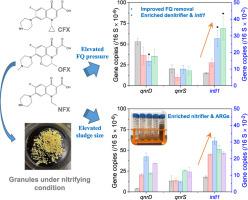Journal of Hazardous Materials ( IF 12.2 ) Pub Date : 2021-02-24 , DOI: 10.1016/j.jhazmat.2021.125527 Yijing Shi , Lei Yang , Shengfa Liao , Liguo Zhang , Zicong Liao , Minyi Lan , Feng Sun , Guang-Guo Ying

|
In this study, aerobic granular sludge (AGS) was operated under high levels of ammonium for removing three fluoroquinolones (FQs), i.e., ciprofloxacin (CFX), ofloxacin (OFX), and norfloxacin (NFX) at 3, 300, and 900 µg/L, respectively. Two key objectives were to investigate the differential distribution of antibiotic resistance genes (ARGs) and mobile genetic elements (MGEs) in sludge fractions and to evaluate correlations between ARGs and MGEs to nitrifying and denitrifying bacteria. AGS showed excellent stability under the exposure of FQs, with nitrite-oxidizing bacteria (NOB) more sensitive to FQs than ammonium-oxidizing bacteria (AOB). Specific oxygen utilization rates (SOUR) showed a reduction of 26.9% for NOB but only 4.0% of the reduced activity of AOB by 3 μg/L FQs. AGS performed better removal efficiencies for CFX and NFX than OFX, and the efficiencies increased with their elevated concentrations, except at 900 μg/L FQs. The elevated FQ concentrations led to a significant enrichment of intI1 and genus Thauera, while qnrD and qnrS showed no accumulation. Compared to nitrifiers, FQs relevant ARGs and the intI1 gene preferred to exist in denitrifiers, and the abundance of denitrifiers behaved a decreasing trend with the sludge size. Two quinoline-degrading bacteria were found in the AGS system, i.e., Alicycliphilus and Brevundimonas, possibly carrying qnrS and qnrD, respectively. Their relative abundance increased with the sludge size, which was 2.18% in sludge <0.5 mm and increased to 3.70% in sludge >2.0 mm, suggesting that the AGS may be a good choice in treating FQs-containing wastewater.
中文翻译:

好氧颗粒污泥对氟喹诺酮类药物的反应:微生物群落变化和抗生素抗性基因
在这项研究中,需氧颗粒污泥(AGS)在高水平的铵下运行,以分别以3、300和900 µg的浓度去除三种氟喹诺酮(FQ),即环丙沙星(CFX),氧氟沙星(OFX)和诺氟沙星(NFX)。 / L。两个主要目标是研究污泥级分中抗生素抗性基因(ARGs)和流动遗传元素(MGEs)的差异分布,以及评估ARGs和MGEs与硝化和反硝化细菌之间的相关性。AGS在FQs暴露下显示出极好的稳定性,其中亚硝酸盐氧化菌(NOB)比铵盐氧化菌(AOB)对FQs更为敏感。比氧利用率(SOUR)显示NOB降低26.9%,但AOB活性降低3μg/ L FQ仅降低4.0%。与OFX相比,AGS对CFX和NFX的去除效率更高,除浓度为900μg/ L的FQ外,效率随浓度的升高而增加。FQ浓度升高导致大量富集intI1和Thauera属,而qnrD和qnrS没有积聚。与硝化器相比,FQs相关的ARGs和intI1基因更倾向于存在于反硝化器中,反硝化器的数量随着污泥尺寸的增加而呈下降趋势。二喹啉降解细菌的AGS系统发现,即Alicycliphilus和短波单胞,可能携带qnrS和qnrD分别。它们的相对丰度随着污泥尺寸的增加而增加,在<0.5 mm的污泥中为2.18%,而在> 2.0 mm的污泥中增加至3.70%,这表明AGS可能是处理含FQs废水的好选择。











































 京公网安备 11010802027423号
京公网安备 11010802027423号